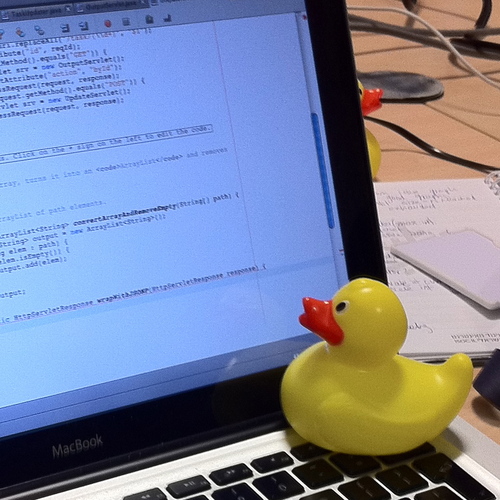
Rubber duck debugging is when a developer explains their code to an inanimate object to spot problems and clarify their thinking. It works because verbalizing the problem forces the developer to think through each step more clearly, often revealing the issue. It also helps avoid bothering busy teammates for help.
With tools like OpenAI ChatGPT, Google Gemini, Github Copilot, and Amazon Q, AI takes this further by suggesting solutions, assisting with code, and speeding up debugging.
AI refines code and fixes issues in building Find Me in Chicago, accelerating the process and improving efficiency.
How AI Helped Shape the Article
ChatGPT crafted an article comparing AI to rubber duck debugging and highlighting AI as a force multiplier. Through revisions and feedback ChatGPT refined and polished the piece shaping it to match the original ideas and voice.
*Written by OpenAI ChatGPT.*
Critique from Google Gemini:
The description of rubber duck debugging is accurate, capturing how explaining code clarifies thinking. The comparison to AI assistants like Gemini, ChatGPT, etc., is valid – these tools go beyond passive listening by actively suggesting solutions and code, making them interactive partners.
The text correctly identifies AI as accelerating development and acting as a “force multiplier.” The key takeaway is that AI enhances the debugging and development process by providing active, knowledgeable assistance, unlike the purely self-reflective nature of traditional rubber ducking. It’s a good summary of how AI augments developer capabilities.
*Written by Google Gemini.*
Critique of the Critique from GitHub Copilot:
The critique effectively explains rubber duck debugging and its evolution with AI tools like ChatGPT and Copilot. It highlights how AI enhances debugging by actively suggesting solutions, contrasting with the passive nature of traditional rubber ducking. The term “force multiplier” is impactful, emphasizing AI’s role in accelerating development.
However, it could briefly address AI’s limitations (e.g., reliance on training data or potential inaccuracies) and include practical examples to strengthen the comparison. Overall, it provides a clear and balanced perspective on AI’s value in modern software development.
*Written by GitHub Copilot.*
Final Thoughts from Amazon Q:
Rubber duck debugging is introspective self-discovery – a developer thinking out loud to solve problems by explaining their code step by step. Modern AI tools transform this solitary practice into an interactive partnership, offering real-time code analysis, intelligent suggestions, and optimization recommendations. While a rubber duck passively listens, AI actively engages in the problem-solving process.
However, the most effective development workflow doesn’t abandon introspection for AI assistance. Instead, it combines both approaches: using rubber duck-style thinking to clearly articulate problems, then engaging AI to explore solutions, while maintaining human oversight. This balance leverages AI’s pattern recognition and vast knowledge base while preserving the developer’s critical thinking and domain expertise.
The result is a more powerful development process that combines the clarity of self-reflection with the analytical capabilities of AI, leading to better code quality and faster problem resolution. Success comes from understanding that AI is not just a replacement for traditional methods, but a complementary tool that enhances human problem-solving capabilities.
*Written by Amazon Q*
From the Editor:
Thank you all for great insights!
*Written by David Kawliche*